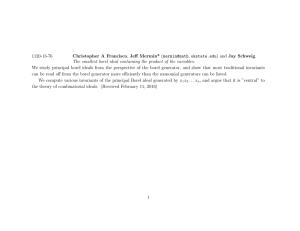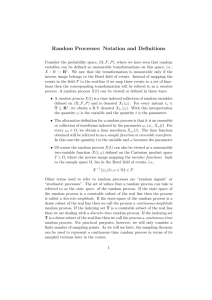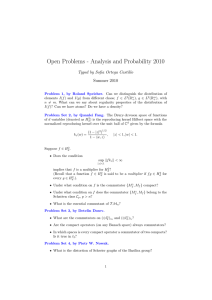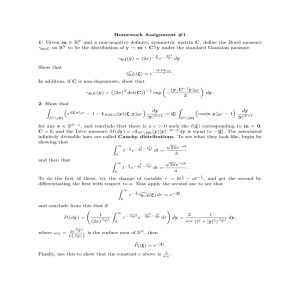Polish spaces and standard Borel spaces
advertisement
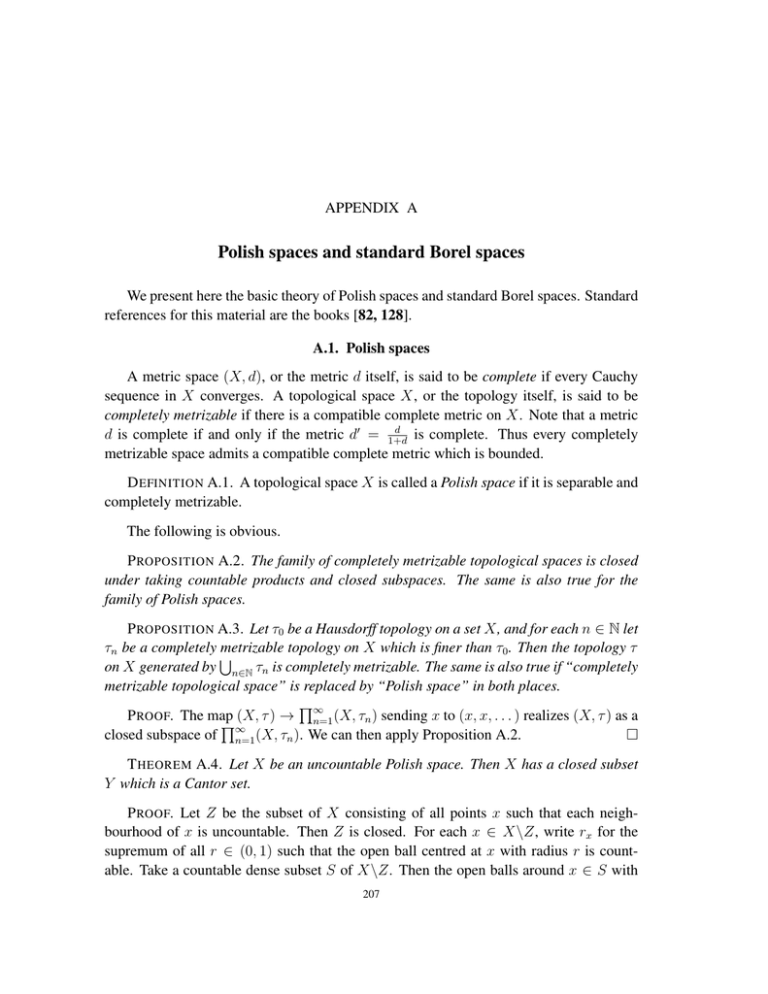
APPENDIX A
Polish spaces and standard Borel spaces
We present here the basic theory of Polish spaces and standard Borel spaces. Standard
references for this material are the books [82, 128].
A.1. Polish spaces
A metric space (X, d), or the metric d itself, is said to be complete if every Cauchy
sequence in X converges. A topological space X, or the topology itself, is said to be
completely metrizable if there is a compatible complete metric on X. Note that a metric
d
is complete. Thus every completely
d is complete if and only if the metric d′ = 1+d
metrizable space admits a compatible complete metric which is bounded.
D EFINITION A.1. A topological space X is called a Polish space if it is separable and
completely metrizable.
The following is obvious.
P ROPOSITION A.2. The family of completely metrizable topological spaces is closed
under taking countable products and closed subspaces. The same is also true for the
family of Polish spaces.
P ROPOSITION A.3. Let τ0 be a Hausdorff topology on a set X, and for each n ∈ N let
τn be a completely metrizable topology on X which is finer than τ0 . Then the topology τ
S
on X generated by n∈N τn is completely metrizable. The same is also true if “completely
metrizable topological space” is replaced by “Polish space” in both places.
Q
P ROOF. The map (X, τ ) → ∞
n=1 (X, τn ) sending x to (x, x, . . . ) realizes (X, τ ) as a
Q∞
closed subspace of n=1 (X, τn ). We can then apply Proposition A.2.
T HEOREM A.4. Let X be an uncountable Polish space. Then X has a closed subset
Y which is a Cantor set.
P ROOF. Let Z be the subset of X consisting of all points x such that each neighbourhood of x is uncountable. Then Z is closed. For each x ∈ X\Z, write rx for the
supremum of all r ∈ (0, 1) such that the open ball centred at x with radius r is countable. Take a countable dense subset S of X\Z. Then the open balls around x ∈ S with
207
208
A. POLISH SPACES AND STANDARD BOREL SPACES
radius 21 rx for x ∈ S cover X\Z. Thus X\Z is countable. Therefore we may assume
that Z = X. Then by a simple recursive procedure over n ∈ N we can construct pairwise disjoint closed balls Bn,1 , Bn,2 , . . . , Bn,2n so that each Bn,k has a positive radius no
larger than 1/n and contains two of the sets Bn+1,1 , Bn+1,2 , . . . , Bn+1,2n+1 . Then clearly
T∞ S2n
n=1
k=1 Bn,k is a closed subset of X and is a Cantor set.
C OROLLARY A.5. Every uncountable Polish space has cardinality 2ℵ0 , where ℵ0 denotes the cardinality of N.
P ROOF. By Theorem A.4 it suffices to show that every Polish space X has cardinality
at most 2ℵ0 . Take a countable dense subset S of X. Then for each x ∈ X we can find
a sequence {xn } in S converging to x. Since the set of sequences in S has cardinality at
most 2ℵ0 , we conclude that X has cardinality at most 2ℵ0 .
T HEOREM A.6 (Kuratowski). Let X be a metric space and let Y be a complete metric
space. Let A be a subset of X and let f : A → Y be a continuous map. Then there exist
a Gδ subset B of X satisfying A ⊆ B ⊆ A and a continuous extension g : B → Y of f .
P ROOF. Since A is Gδ in X, we may assume that A = X. For each n ∈ N write
Bn for the union of all open sets U in X which satisfy diam(f (A ∩ U )) ≤ 1/n. Then
T
B := n∈N Bn is a Gδ subset of X and A ⊆ B by the continuity of f . It is clear that
T
for each x ∈ B the intersection U f (A ∩ U ) over all open neighbourhoods U of x is
a singleton, say {y}. Set g(x) = y. Then it is readily checked that g is continuous and
extends f .
P ROPOSITION A.7. Let X be a completely metrizable topological space and let Y
be a nonempty subset of X. Then Y is a completely metrizable topological space if and
only if Y is a Gδ subset of X. The same is also true if “completely metrizable topological
space” is replaced by “Polish space” in both places.
P ROOF. It suffices to prove the assertion for the case of completely metrizable spaces.
The “only if” part follows from Theorem A.6. For the the converse, let d be a compatible
1
1
− d(z,X\Y
|
complete metric on X. If Y is open, then d′ (y, z) := d(y, z) + | d(y,X\Y
)
T∞ )
defines a compatible complete metric on Y . If Y is a Gδ , say Y = n=1 Un for some
Q
open sets Un in X, then the map Y → ∞
n=1 Un sending y to (y, y, . . . ) realizes Y as a
Q
closed subspace of ∞
U
,
in
which
case
we conclude by Proposition A.2 that Y is a
n=1 n
completely metrizable space.
P ROPOSITION A.8. Every Polish space is homeomorphic to a Gδ subset of [0, 1]N .
P ROOF. Let X be a Polish space and d a compatible metric on X, which we may
d
if necessary. Take a dense sequence
assume to be bounded by 1 by replacing it with 1+d
A.1. POLISH SPACES
209
{pn } in X. Then the map X → [0, 1]N sending x to (d(x, pn ))n∈N is clearly a homeomorphism of X onto its image. By Propositions A.2 and A.7, the image of X is a Gδ subset
of [0, 1]N .
E XAMPLE A.9. Clearly every Polish space is second countable, i.e., has a countable
basis for the topology. Conversely, every second countable locally compact Hausdorff
space is Polish. To see this, notice first that if we are given a basis for the topology of a
locally compact Hausdorff space X then the elements in the basis with compact closure
also form a basis. Thus any second countable locally compact Hausdorff space X has a
countable basis consisting of open sets with compact closure, and hence can be written as
S
n∈N Kn where each Kn is compact and contained in the interior of Kn+1 . It follows that
the one-point compactification X̃ of X is also second countable. By Proposition A.7, if
X̃ is Polish then so is X. Take a countable basis U for the topology on X̃. Then U is an
open cover of X̃. For each finite subcollection V of U which covers X̃, choose a partition
of unity {fV,U }U ∈V over X which is subordinate to V. Then, with the index V ranging
Q Q
over all finite subcollections of U which cover X̃, the map X̃ → V U ∈V [0, 1] which
sends x to {{fV,U (x)}U ∈V }V is a homeomorphism of the compact space X̃ onto a closed
Q Q
subset of V U ∈V [0, 1]. By Proposition A.2, X̃ is Polish.
E XAMPLE A.10. Let X be a second countable locally compact Hausdorff space and
let Y be a Polish space. Equip the space C(X, Y ) of continuous maps X → Y with the
compact-open topology, i.e., the topology generated by the sets O(K, U ) consisting of
continuous maps X → Y sending K into U where K ranges over the compact subsets
of X and U over the open subsets of Y . Then C(X, Y ) is Polish. To see this, write
S
X as ∞
n=1 Kn where each Kn is compact and contained in the interior of Kn+1 (see
Example A.9), and let d be a bounded complete metric on Y . Then
∞
X
1
max d(f (x), g(x))
d (f, g) =
2n x∈Kn
n=1
′
is a metric on C(X, Y ) inducing the compact-open topology. It is easy to see that d′ is
complete. Thus it remains to prove that C(X, Y ) is separable. For this it suffices to show
that C(Kn , Y ) is separable for each n. By Proposition A.8, we can identify Y with a Gδ
subset of RN . Then C(Kn , Y ) with the compact-open topology is clearly a subspace of
C(Kn , RN ). Thus it is enough to show that C(Kn , RN ) is a separable metrizable space.
Clearly C(Kn , RN ) = (C(Kn , R))N as topological spaces. By the Stone-Weierstrass theorem, C(Kn , R) is Polish. It follows by Proposition A.2 that C(Kn , RN ) = (C(Kn , R))N
is Polish.
210
A. POLISH SPACES AND STANDARD BOREL SPACES
A.2. Standard Borel spaces
For a family τ of subsets of a set X, we denote by B(τ ) the σ-algebra generated by τ .
A measurable space (X, S) is called a standard Borel space if it is isomorphic to (Y, B(τ ))
for some Polish space (Y, τ ). A subset of a topological space is said to be clopen if it is
both closed and open.
T HEOREM A.11. Let (X, τ ) be a Polish space. Let A ∈ B(τ ). Then there exists a
Polish topology τA on X finer than τ such that B(τA ) = B(τ ) and A is clopen in (X, τA ).
P ROOF. Denote by A the set of all A ∈ B(τ ) satisfying the conclusion of the theorem.
It suffices to show that A is a σ-algebra containing τ . Let A ∈ τ . By Proposition A.7,
both A and X\A are Polish spaces. Denote by τA the topology on the disjoint union of
A and X\A. Then clearly τA is Polish and finer than τ , and also τA ⊆ B(τ ), whence
B(τA ) = B(τ ). Moreover, A is clopen in (X, τA ). This proves that τ ⊆ A.
Now we show that A is a σ-algebra. Let {An }∞
be a sequence in A. By PropoSn=1
∞
sition A.3, the topology τA on X generated by n=1 τAn is Polish and finer than τ .
Since each τAn has a countable basis and is contained in B(τ ), it is readily checked that
S
τA ⊆ B(τ ). Thus B(τA ) = B(τ ). Note that n∈N An is open in τA . By the first paragraph,
there exists a Polish topology τA′ on X finer than τA such that B(τA′ ) = B(τA ) = B(τ )
S
′
and ∞
n=1 An is clopen in (X, τA ). Therefore A is closed under taking countable unions.
Finally, if A is a member of B(τ ) which belongs to A, then clearly X\A also belongs to
A, and so we conclude that A is a σ-algebra.
The following corollary is a consequence of Theorem A.11 and Proposition A.3.
C OROLLARY A.12. Let (X, τ ) be a Polish space and let Y be a second countable
topological space. Let f : X → Y be a Borel map. Then there exists a Polish topology τf
on X finer than τ such that B(τf ) = B(τ ) and f : (X, τf ) → Y is continuous.
T HEOREM A.13. Let (X, S) and (Y, T) be measurable spaces. Let f : X → Y and
g : Y → X be injections with f (S) ⊆ T and g(T) ⊆ S such that each establishes an
isomorphism of measurable spaces onto its image. Then there exist A ∈ S and B ∈ T such
that f (A) = Y \B and g(B) = X\A. In particular, (X, S) and (Y, T) are isomorphic.
S
P ROOF. Set B1 = Y \f (X), B = n≥0 (f ◦ g)n B1 , and A = X\g(B). Then g(B) =
X\A and
f (A) = f (X)\g(B) = f (X)\(f ◦ g)B = Y \(B1 ∪ (f ◦ g)B) = Y \B.
As a direct consequence of Theorem A.11 we get the following.
C OROLLARY A.14. Let (X, S) be a standard Borel space and let Y be a nonempty
set in S. Then (Y, S|Y ) is also a standard Borel space.
A.2. STANDARD BOREL SPACES
211
L EMMA A.15. Let {(Xn , τn )} be a sequence of second countable topological spaces.
Q
Q
Q
Then B( ∞
τn ) is exactly ∞
), i.e., the smallest σ-algebra on ∞
n=1 B(τ
n=1 Xn conQn∞
S∞n=1 −1
taining n=1 πn (B(τn )), where πn : m=1 Xm → Xn is the coordinate projection map.
P ROOF. Since πn−1 (B(τn )) = B(πn−1 (τn )) for each n ∈ N, we have
∞
∞
[
Y
B(τn ) = B
πn−1 (τn ) .
n=1
n=1
For every n ∈ N, take a countable basis Un for τn . Denote by U the family of subsets of
T
X of the form nk=1 πk−1 (Uk ), where n ∈ N and Uk ∈ Uk for all k = 1, . . . , n. Then U is
Q
a countable basis for ∞
n=1 τn . Consequently
∞
∞
∞
Y
[
Y
−1
πn (τn ) =
τn = B(U) = B
B(τn ).
B
n=1
n=1
n=1
L EMMA A.16. The closed unit interval [0, 1] equipped with the Borel structure associated to the standard topology is isomorphic to the Cantor set equipped with its Borel
structure.
P ROOF. Define a map ϕ : {0, 1}N → [0, 1] by
∞
X
1
ϕ((an )) =
an .
2n
n=1
Clearly ϕ is continuous and surjective. Denote by Y the set of points in [0, 1] with
more than one preimage under ϕ. Then both Y and ϕ−1 (Y ) are countably infinite. It
is readily checked that the restriction of ϕ to {0, 1}N \ϕ−1 (Y ) is a homeomorphism onto
[0, 1]\Y , and hence a Borel isomorphism. Take a bijection ψ from ϕ−1 (Y ) onto Y . Define φ : {0, 1}N → [0, 1] to be ϕ on {0, 1}N \ϕ−1 (Y ) and ψ on ϕ−1 (Y ). Then φ is a Borel
isomorphism.
T HEOREM A.17. Two standard Borel spaces are isomorphic if and only if they have
the same cardinality, and any two uncountable standard Borel spaces are isomorphic.
P ROOF. For the nontrivial direction of the equivalence, observe first that two countable standard Borel spaces with the same cardinality are clearly isomorphic. Fixing a
Cantor set (C, τ ), it thus suffices to show that every uncountable standard Borel space
(X, S) is isomorphic to (C, B(τ )). By Theorem A.13 it is then enough to show that there
are injections f : C → X and g : X → C with f (B(τ )) ⊆ S and g(S) ⊆ B(τ ) such that
each establishes an isomorphism of measurable spaces onto its image.
Fix a Polish topology τX on X such that S = B(τX ). By Theorem A.4 there exists
a homeomorphism f from (C, τ ) onto a closed subspace Z of (X, τX ). Then f is an
isomorphism from (C, B(τ )) onto (Z, S|Z ).
212
A. POLISH SPACES AND STANDARD BOREL SPACES
To construct g, we first apply Proposition A.8 to obtain an embedding ϕ : X → [0, 1]N
whose image is a Gδ subset of [0, 1]N . Then ϕ is a Borel isomorphism from (X, S) onto
ϕ(X). Since C N is homeomorphic to C, by Lemmas A.15 and A.16 there is an isomorphism ψ from [0, 1]N , equipped the Borel structure associated to the product topology, to
(C, B(τ )). Now take g to be ψ ◦ ϕ.
A.3. Measures on standard Borel spaces
P ROPOSITION A.18. Let (X, τ ) be a metrizable topological space and let µ be a finite
measure on B(τ ). Then for each A ∈ B(τ ) one has
µ(A) = sup{µ(F ) : F ⊆ A and F is closed} = inf{µ(U ) : A ⊆ U and U is open}.
P ROOF. Denote by A the set of all A ∈ B(τ ) satisfying the above conditions. It is
easily checked that A is a σ-algebra on X containing τ . Thus A = B(τ ).
A finite Borel measure µ on a topological space X is said to be regular if for every
Borel set A ⊆ X one has
µ(A) = sup{µ(F ) : F ⊆ A and F is compact} = inf{µ(U ) : A ⊆ U and U is open}.
Together with Proposition A.18, the following proposition shows that every finite Borel
measure on a Polish space is regular.
P ROPOSITION A.19. Let (X, τ ) be a Polish space and let µ be a finite measure on
B(τ ). Then for each A ∈ B(τ ) one has
µ(A) = sup{µ(F ) : F ⊆ A and F is compact}.
P ROOF. By Proposition A.18 it suffices to consider the case that A is closed. Thus
we may assume that A = X. Let S be a countable dense subset of X. Let ε > 0. For
each n ∈ N, the collection {B(x, n1 )}x∈S of closed balls of radius n1 centred at points in S
S
covers X, and so we can find a finite set Sn ⊆ S such that µ(X\ x∈Sn B(x, n1 )) < ε/2n .
P∞
S
T
S
1
1
Set F = ∞
x∈Sn B(x, n )) < ε. Since
n=1 µ(X\
n=1
x∈Sn B(x, n ). Then µ(X\F ) ≤
F is complete and totally bounded, it is compact.
Let (X, S) be a measurable space such that {x} ∈ S for every x ∈ X. A measure µ
on (X, S) is said to be atomless if µ({x}) = 0 for every x ∈ X. If (X, S) and (Y, T) are
measurable spaces, f : X → Y is a measurable map, and µ is a measure on S, then we
write f∗ µ for the push forward measure on T, which is defined by f∗ µ(A) = µ(f −1 (A))
for all A ∈ T.
T HEOREM A.20. Let µ be an atomless probability measure on a standard Borel space
(X, S). Then there is a Borel isomorphism f : X → [0, 1] for the Borel structure coming
from the standard topology on [0, 1] such that f∗ µ is Lebesgue measure on [0, 1].
A.4. BOREL MAPS AND DISJOINTNESS OF IMAGES
213
P ROOF. Of course X must be uncountable. By Theorem A.17 we may assume that
(X, S) is the unit interval [0, 1] with the Borel structure coming from its standard topology.
Consider the function g : X → [0, 1] defined by g(x) = µ([0, x]). This is an increasing
function with g(1) = 1. Since µ is atomless, it is easy to see that g is continuous and
g(0) = 0. Thus g is surjective. Clearly g∗ µ([0, t]) = t for every t ∈ [0, 1]. It follows that
g∗ µ and Lebesgue measure coincide on open subsets of [0, 1]. By Proposition A.18 they
coincide on all Borel subsets of [0, 1].
Clearly g −1 (t) is an interval, possibly of length 0, for each t ∈ [0, 1]. Write D for
the set of all t ∈ [0, 1] such that g −1 (t) has positive length. Then D is countable. It is
clear that g restricts to a Borel isomorphism from X\g −1 (D) onto [0, 1]\D. If D is empty
then we may take f = g to get the conclusion of the theorem. Suppose then that D is
nonempty. Choose a Borel set E ⊆ [0, 1] with cardinality 2ℵ0 and Lebesgue measure 0
(for example, the middle thirds Cantor set). Then µ(g −1 (D ∪ E)) = 0, and g restricts to
a measure-preserving Borel isomorphism from X\g −1 (D ∪ E) onto [0, 1]\(D ∪ E). By
Corollary A.14, both D ∪ E equipped with the restriction of the Borel structure on [0, 1]
and g −1 (D ∪ E) equipped with the restriction of S are standard Borel spaces. Thus by
Theorem A.17 they are isomorphic. Define a map f : X → [0, 1] so that f coincides with
g on X\g −1 (D ∪ E) and restricts to a Borel isomorphism from g −1 (D ∪ E) onto D ∪ E.
Then f satisfies the requirements.
A.4. Borel maps and disjointness of images
Proposition A.22 below is useful for converting freeness for a p.m.p. action (Definition 1.2) into a property involving the disjointness of images of nonnull sets under the
action of finitely many group elements (Proposition 1.4). This property gets applied in
a crucial way in the proof of the Rokhlin lemma (Theorem 3.43 and, in the case of Zactions, Lemma 3.72).
P ROPOSITION A.21. Let (X, S) and (Y, T) be standard Borel spaces, and let f, g :
X → Y be Borel maps. Then the set {x ∈ X : f (x) = g(x)} belongs to S.
P ROOF. Let τ be a Polish topology on Y such that T = B(τ ). By Proposition A.2,
Y × Y is a Polish space. Note that the product Borel structure T 2 on Y × Y is exactly
the Borel structure generated by the product topology. In particular, the diagonal ∆ :=
{(y, y) : y ∈ Y } belongs to T 2 . Observe also that the map h : (X, S) → (Y × Y, T 2 )
given by x 7→ (f (x), g(x)) is Borel. Thus the set h−1 (∆) = {x ∈ X : f (x) = g(x)}
belongs to S.
P ROPOSITION A.22. Let (X, S) and (Y, T) be standard Borel spaces and let µ be a
measure on S. Let f, g : X → Y be Borel maps such that the set {x ∈ X : f (x) = g(x)}
214
A. POLISH SPACES AND STANDARD BOREL SPACES
has µ-measure 0. Let A be a member of S with µ(A) > 0. Then there exists a B ∈ S such
that B ⊆ A, µ(B) > 0, and f (B) ∩ g(B) = ∅.
P ROOF. By Proposition A.21, the set Z := {x ∈ X : f (x) 6= g(x)} belongs to
S. Let τX be a Polish topology on X with B(τX ) = S and τY a Polish topology on Y
with B(τY ) = T. By Corollary A.12 we may assume that both f and g are continuous.
Then each z ∈ Z has a neighbourhood U such that f (U ) ∩ g(U ) = ∅. Fix a metric on
X inducing τX . For each z ∈ Z let rz be the supremum of all r ∈ (0, 1) such that the
open ball Vr,z in X centred at z with radius r satisfies f (Vr,z ) ∩ g(Vr,z ) = ∅. As (X, τX )
is separable there is a countable dense subset S of Z. Then the collection {Vz,rz /2 }z∈S
covers Z. As µ(A ∩ Z) = µ(A) > 0, we see that µ(A ∩ Z ∩ Vw,rw /2 ) > 0 for some w ∈ Z.
Then the set B := A ∩ Z ∩ Vw,rw /2 satisfies the requirements.
